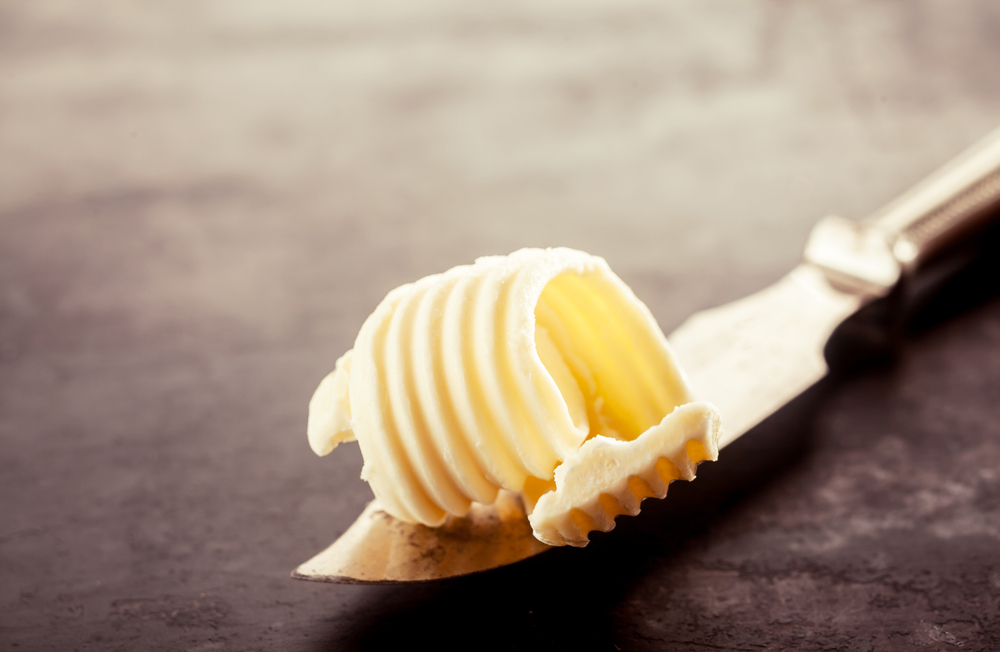
Vilified for years and substituted with other lesser 'butter-like' substances such as margarine and vegetable oil spreads, butter was thought to contribute to heart disease due to its saturated fat content. However, critical analysis of the evidence between certain types of saturated fat and cardiovascular disease, do not support its link to heart disease. Real butter, especially the organic and from grass-fed animals, offers a number of benefits as a healthy fat. Butter has the fatty acids omega-3 and omega-6 which, help brain function and are necessary for skin health. In addition to essential fatty acids butter is ladden with other important nutrients such as vitamin A (important for maintaining good vision, a healthy immune system and hormonal health), other fat soluble vitamins (D, E and K), minerals such as selenium (a powerful antioxidant) and butyric acid- this fatty acid is used as a food source by the good gut bacteria to keep inflammation at bay and promote intestinal health.
Another way to enjoy the benefits of butter is by consuming its Indian version - ghee. Ghee, also known as clarified butter, is a result of heating butter on a low simmer and removing the milk proteins. Ghee is a great alternative for those who suffer from lactose intolerance and is the best form of butter to cook with due to its high smoking point.
One of the most common complaints I hear from people about using butter is that it is so hard to spread when it is kept in the fridge. My solution: mix butter with extra virgin olive oil for easier spreadability and a boost of health benefits. To make an easy butter and olive oil spread with no added nasties, add one soft stick of butter and aproximately half of one cup of extra virgin olive oil. Mix thoroughly in a bowl and transfer to a dish to store in the fridge. You can play around with the quantities of olive oil until you get the desired consistency and spreadability.
One way to enjoy butter is by having it on your veggies. Research shows that eating vegetables with high-fat dairy products such as butter actually increases the amount of nutrients the body extracts from the vegetables. This is because many of the vitamins and micronutrients in vegetables are fat-soluble meaning that they cannot be absorbed without the presence of fat.
So the next time you're serving vegetables, pour some butter on them!
Recipe
Try this easy garlic butter to go with your vegetables:
1 tablespoon of organic butter
1 crushed and chopped garlic clove
Place butter and garlic in a small pot.
Melt the butter over low heat. Once melted and infused with garlic, remove from heat and pour over steammed vegetables.
Serves 1.
Enjoy!
References
Hyman, M 2016, Eat Fat Get Thin, Hodder & Stoughton, UK.
Holmberg, S., Thelin, A. and Stiernström, E.L., 2009. Food choices and coronary heart disease: a population based cohort study of rural Swedish men with 12 years of follow-up. International journal of environmental research and public health, 6(10), pp.2626-2638.
Lawrence, G.D., 2013. Dietary fats and health: dietary recommendations in the context of scientific evidence. Advances in Nutrition: An International Review Journal, 4(3), pp.294-302.
Volk, M.G., 2007. An examination of the evidence supporting the association of dietary cholesterol and saturated fats with serum cholesterol and development of coronary heart disease. Alternative Medicine Review, 12(3), pp.228-246.
Wahlqvist, M 2002, Food & Nutrition, 2nd edn, Allen & Unwin, NSW, Australia.